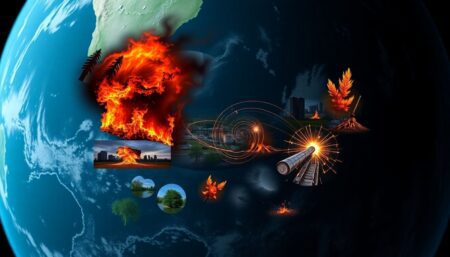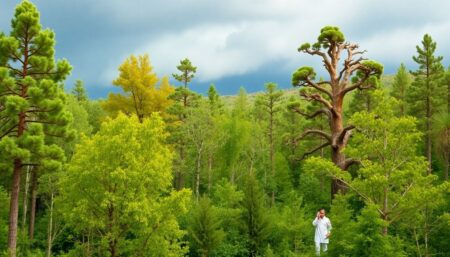Have you ever wondered how early desert dwellers managed to survive in the scorching heat, with limited water sources, and harsh, unforgiving landscapes? The desert, with its arid climate and extreme temperatures, is often perceived as a hostile environment, but it doesn’t have to be a death sentence. In fact, with the right knowledge, preparation, and tactics, you can not only survive but thrive in the desert. This comprehensive guide is designed to equip you with just that
- hot weather prepping strategies, desert survival techniques, and arid climate tactics to ensure you’re ready for any desert challenge that comes your way.
First, let’s address the elephant in the room. The desert is no walk in the park. According to the World Population Review, deserts cover around 20% of the Earth’s land surface, and they’re expanding at an alarming rate due to climate change. The average temperature in the desert can soar to 50°C (122°F), and the humidity is often so low that sweat evaporates before it can cool you down. So, the question is, how do you stay cool, hydrated, and safe in such an environment?
This article aims to provide a detailed, step-by-step approach to desert survival, focusing on hot weather prepping and arid climate tactics. By the end of this guide, you’ll have a solid understanding of how to navigate the desert, how to find and purify water, how to protect yourself from the sun and heat, and how to find or create shade. You’ll also learn about essential gear, first aid, and how to signal for help if needed. In essence, this guide promises to turn you from a desert novice into a seasoned prepper, ready to face the challenges of the arid climate head-on. So, buckle up, and let’s dive into the fascinating world of desert survival.
Thriving in the Arid Wilderness: A Comprehensive Guide to Desert Survival in Hot Weather
Embarking on a journey through the arid wilderness, one must first understand that the desert is not a barren wasteland, but a vibrant ecosystem teeming with life, albeit adapted to survive in harsh, hot conditions. The key to thriving in this environment lies in respecting its rules and learning from its inhabitants. The sun, the desert’s most formidable adversary, also presents an opportunity. Solar energy can be harnessed to purify water, providing a lifeline in a landscape where water is scarce. Camels, the ships of the desert, have evolved to conserve water, a lesson humans can adopt by minimizing sweat and maximizing shade. The desert’s nocturnal creatures offer another insight; they are active when the sun is not, a strategy that can help humans avoid the scorching heat. Navigation is another crucial skill. The desert’s vast expanse can disorient, but understanding the stars, the sun’s path, and the subtle changes in the landscape can keep one on track. Plants, too, have a role to play. Many desert species store water, providing sustenance for both humans and animals. However, it’s crucial to know which are safe to consume. The desert’s harsh beauty demands respect, but with knowledge and understanding, it can be navigated and survived. After all, every challenge is an opportunity for growth, and every wilderness, a chance to learn.
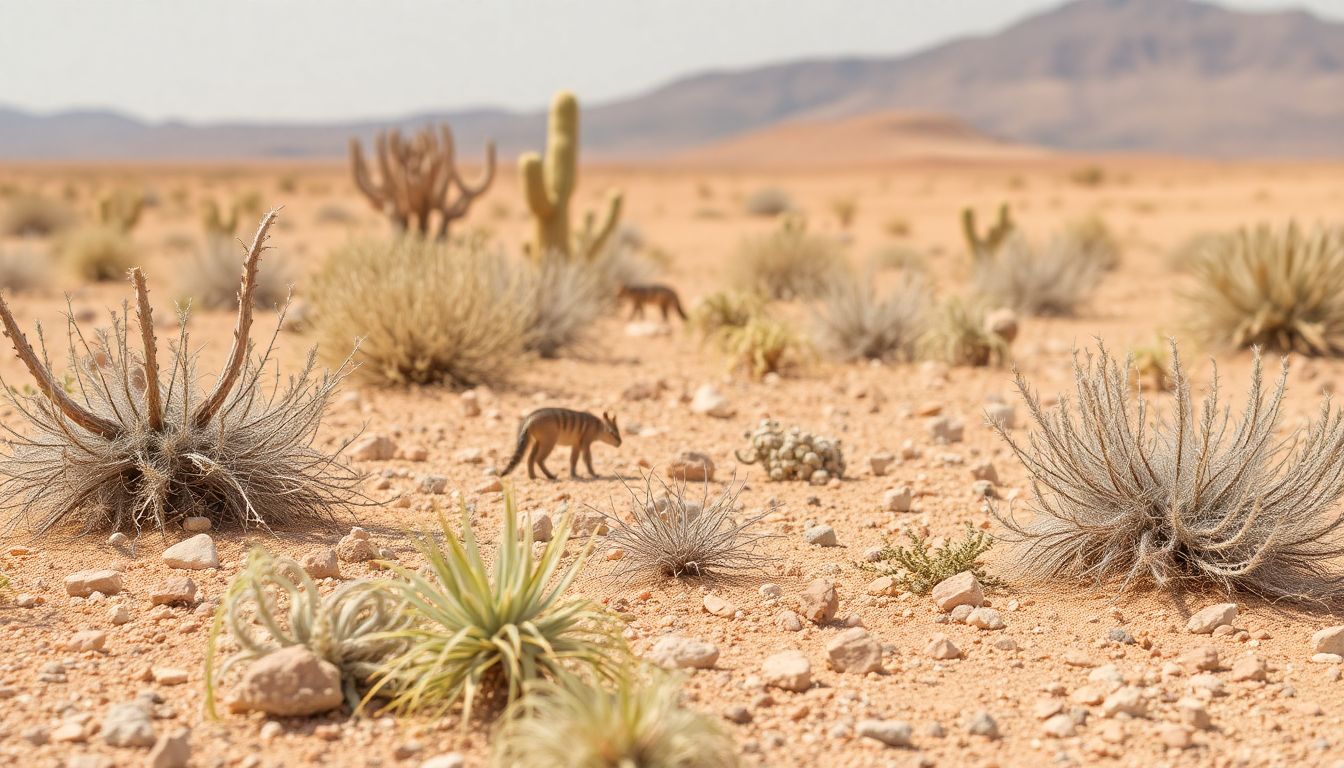
Understanding the Desert Environment
Deserts, often perceived as barren and inhospitable, are in fact teeming with life and present unique challenges and opportunities for survival. These vast, arid landscapes cover approximately one-fifth of the Earth’s land surface, yet they are home to a diverse array of flora and fauna that have evolved remarkable adaptations to thrive in this harsh environment.
The first step in understanding and navigating a desert ecosystem is to familiarize oneself with its climate patterns. Deserts can be categorized into different types based on their location and precipitation levels, each with its own distinct climate. For instance, cold deserts like the Gobi have long, harsh winters, while hot deserts like the Sahara experience extreme heat and little rainfall. Understanding these patterns is crucial for planning when and how to travel, as well as what resources might be available.
Next, it’s essential to learn about the local flora. Deserts are not devoid of plants; they are just sparse and often hidden beneath the sand. Many desert plants have deep root systems that can reach water sources far below the surface, or they may be succulents that store water in their leaves or stems. Some plants, like the Saguaro cactus, can even provide life-saving water for humans in desperate situations. Knowing which plants are safe to consume and which ones are toxic can mean the difference between survival and disaster.
Desert fauna also presents unique challenges and opportunities. Many desert animals are nocturnal, active during the cooler night hours to avoid the scorching daytime heat. Some, like the Fennec fox, have evolved to conserve water by producing concentrated urine and feces, and by panting to cool their bodies. Understanding the behavior and habits of desert animals can help one avoid dangerous encounters and perhaps even find sources of food or water.
In conclusion, understanding the desert environment is not just about knowing the climate and landscape, but also about recognizing the intricate web of life that exists within it. By studying the flora and fauna, and their adaptations to the desert climate, one can gain valuable insights into effective survival strategies. It’s a testament to the resilience and adaptability of life that even in the harshest of environments, there is still so much to learn and appreciate.

Protecting Yourself from the Heat
When the desert sun beats down, it’s not just the temperature that’s scorching, but also the radiant heat that can sap your energy and pose serious health risks. Understanding the science behind heat exhaustion and heatstroke is the first step in protecting yourself. Heat exhaustion occurs when your body’s heat regulation mechanisms become overwhelmed by excessive heat. Sweating is your body’s primary cooling system, but if you lose too much fluid or sweat isn’t evaporating quickly enough, your core body temperature can rise to dangerous levels, leading to heatstroke, a life-threatening emergency.
To stay cool in the desert, hydration is your most powerful ally. Water is not just a beverage; it’s your body’s lifeline. Aim to drink water regularly, even if you don’t feel thirsty. A good rule of thumb is to drink about 16 ounces of water every hour in hot weather.
Your clothing choices can also make a significant difference. Opt for lightweight, light-colored, and loose-fitting clothing. These fabrics and colors reflect heat and allow sweat to evaporate more efficiently, keeping you cooler. Don’t forget to protect your head and neck with a wide-brimmed hat and a bandana or neckerchief.
Shade is your friend in the desert. Whenever possible, stay in the shade, especially during the hottest part of the day. If you’re hiking or exploring, plan your route to include shady spots. If you’re driving, park in the shade or use a windshield sunshade.
Here are some additional tips to keep you cool and safe in the desert:
- Wear sunscreen with at least SPF 30 to protect your skin from harmful UV rays.
- Avoid heavy meals and alcohol, as they can increase your body heat.
- If you feel faint, dizzy, or excessively tired, stop what you’re doing, find shade, and hydrate immediately.
- Never leave children or pets in parked cars, even with the windows cracked.
By following these guidelines, you can enjoy the desert’s unique beauty while staying safe and comfortable.
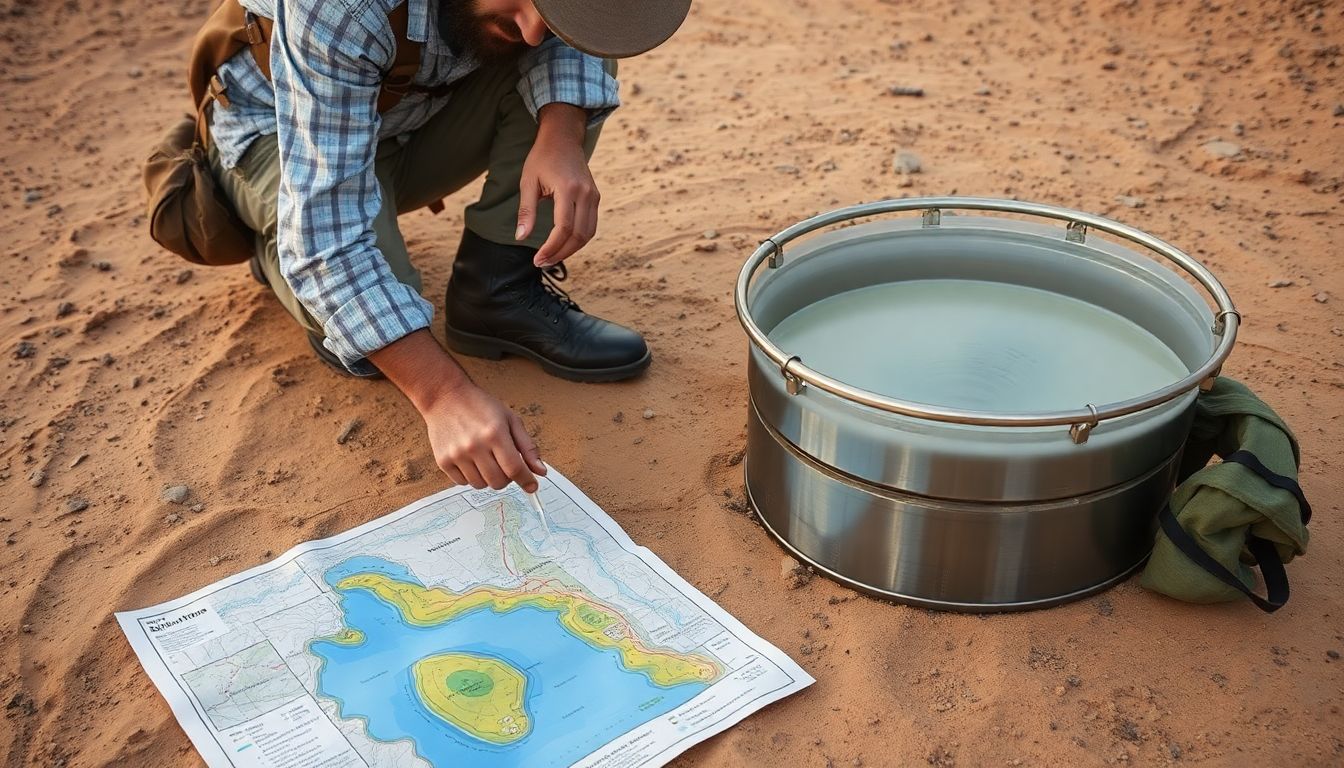
Water: The Desert’s Most Precious Resource
In the harsh, unforgiving landscape of the desert, water is not just a necessity, it’s the most precious resource. It’s the difference between life and death, the key to survival. Understanding how to find, purify, and conserve water is crucial for anyone venturing into these arid regions.
The human body can survive for weeks without food, but only a few days without water. This makes water our top priority in a desert survival situation. The first step is to understand that water is everywhere, it’s just hidden. Plants, animals, and geological features can all point us towards water sources.
Let’s start with finding water. Look for signs of life. Where there’s life, there’s water. Trees, bushes, and animals all need water to survive. Follow animal tracks, especially those of birds, as they often lead to water. Also, look for depressions in the ground, known as ‘dry washes’, which can fill with water during rainstorms.
Once you’ve found a water source, the next challenge is purifying it. Desert water can be contaminated with bacteria, viruses, and even salt. Here are some simple purification methods:
- Boiling: Bring water to a rolling boil for at least one minute. This will kill all pathogens.
- Purification tablets: These are available at outdoor stores and contain chemicals like iodine or chlorine dioxide that kill bacteria and viruses.
- Solar disinfection: Fill a clear plastic bottle with water and leave it in direct sunlight for at least six hours. The sun’s UV rays can kill bacteria and viruses.
Conserving water is just as important as finding and purifying it. Here are some strategies:
- Stay hydrated: Drink water regularly, even if you don’t feel thirsty. Dehydration can sneak up on you.
- Cover your head: The sun’s rays can quickly dehydrate you. Wear a hat and cover your neck and ears.
- Find shade: Rest during the hottest part of the day and move around in the cooler hours.
- Store water wisely: If you find a water source, store the water in a cool, shady place. You can also dig a pit and line it with plastic to create a makeshift refrigerator.
Water is the desert’s most precious resource, and understanding how to manage it can mean the difference between life and death. So, stay hydrated, stay smart, and respect the desert’s thirst.
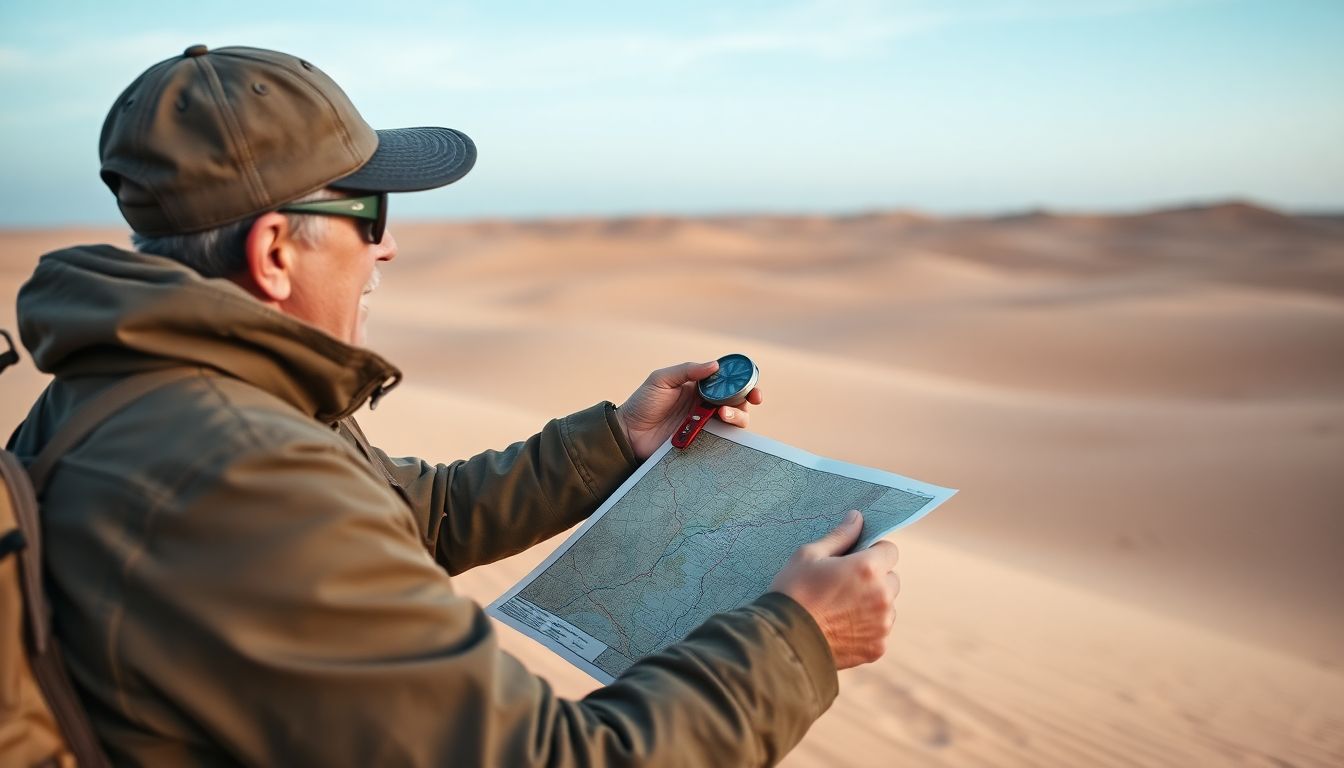
Navigating the Desert: Finding Your Way
Navigating the desert, a vast and seemingly featureless expanse, presents unique challenges that can test even the most seasoned explorer. The primary difficulty lies in the lack of distinct landmarks, making it easy to lose one’s bearings. The sun, a constant companion, can be both a blessing and a curse. Its intense heat and glare can disorient and tire, while its position in the sky can also provide crucial navigational cues.
The sun’s arc across the sky is predictable, rising in the east and setting in the west. By understanding this pattern, one can use the sun’s position to determine direction. For instance, in the Northern Hemisphere, the sun will be on your right during the morning hours and on your left in the afternoon. However, this method is not foolproof, as clouds and varying terrain can obscure the sun’s position.
At night, the stars become invaluable allies. The North Star, or Polaris, is a beacon for travelers. By finding this star and using it in conjunction with the horizon, one can determine north. However, this method requires clear skies and a basic understanding of the night sky.
Landmarks, though scarce, can be crucial. Any distinctive feature, such as a rock formation or a lone tree, can serve as a reference point. It’s essential to note these landmarks and use them to plot your course.
Maps, compasses, and GPS devices are invaluable tools in the desert. A map provides a bird’s eye view of the terrain, helping to plan routes and avoid hazards. A compass, when used correctly, can point to the cardinal directions. However, it’s crucial to understand that a compass needle points to magnetic north, not true north, and there’s a difference between the two.
GPS devices offer real-time location data, but they rely on batteries and signals, which can fail in the desert. It’s essential to use these devices in conjunction with traditional navigation methods, not as a sole means of navigation.
In conclusion, navigating the desert requires a combination of understanding natural phenomena, using tools effectively, and maintaining a keen eye for landmarks. It’s a skill that demands patience, practice, and a deep respect for the desert’s unique challenges.
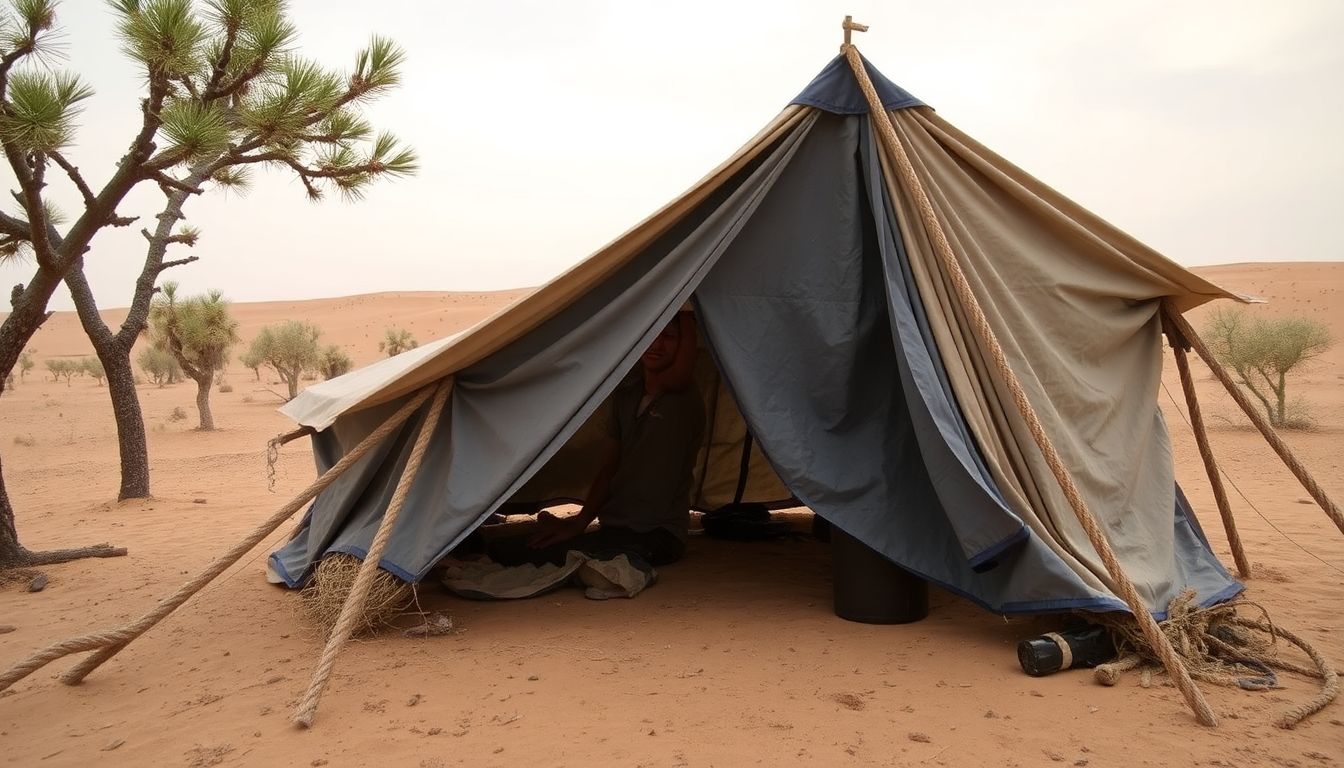
Shelter: Protecting Yourself from the Elements
In the vast, sun-scorched expanse of the desert, shelter is not just a luxury, but a necessity. The desert’s duality
- its scorching days and freezing nights
- makes finding adequate shelter a critical survival skill. A well-built shelter can mean the difference between life and death, providing refuge from the relentless sun, the chilling cold, and the howling winds.
The primary goal of a desert shelter is to provide shade and insulation. Here are some strategies for building effective shelters using natural materials:
- Rock and Soil Shelters: These are excellent for desert environments as they provide excellent insulation. You can create a simple rock shelter by finding a natural overhang and piling rocks around it to block the wind. Alternatively, you can dig a pit and cover it with a layer of soil and debris for insulation.
- Debris Huts: These are quick and easy to build. Gather long, sturdy branches and weave them together to create a framework. Then, cover this framework with debris like leaves, grass, and small branches. Ensure the debris is thick enough to provide insulation and block the wind.
- Tarp Shelters: If you have a tarp, you can create a simple and effective shelter. Find a long, sturdy branch and prop one end of the tarp on it. Then, dig a trench for the other end to create a slanted roof that sheds rain and provides shade.
Each shelter type has its pros and cons. Rock and soil shelters provide excellent insulation but can be time-consuming to build. Debris huts are quick and easy but may not provide as much insulation. Tarp shelters are versatile but require a tarp and may not provide as much insulation as other types. The key is to adapt these shelters to the desert environment by ensuring they provide shade and insulation.
Remember, the ideal shelter should be large enough to fit in, easy to build, provide shade, retain heat, and blend in with the environment. It’s also crucial to choose a sheltered spot, away from prevailing winds and potential flash floods. With the right knowledge and materials, you can turn the desert’s harsh elements into a protective barrier, ensuring your survival in this unforgiving yet beautiful landscape.
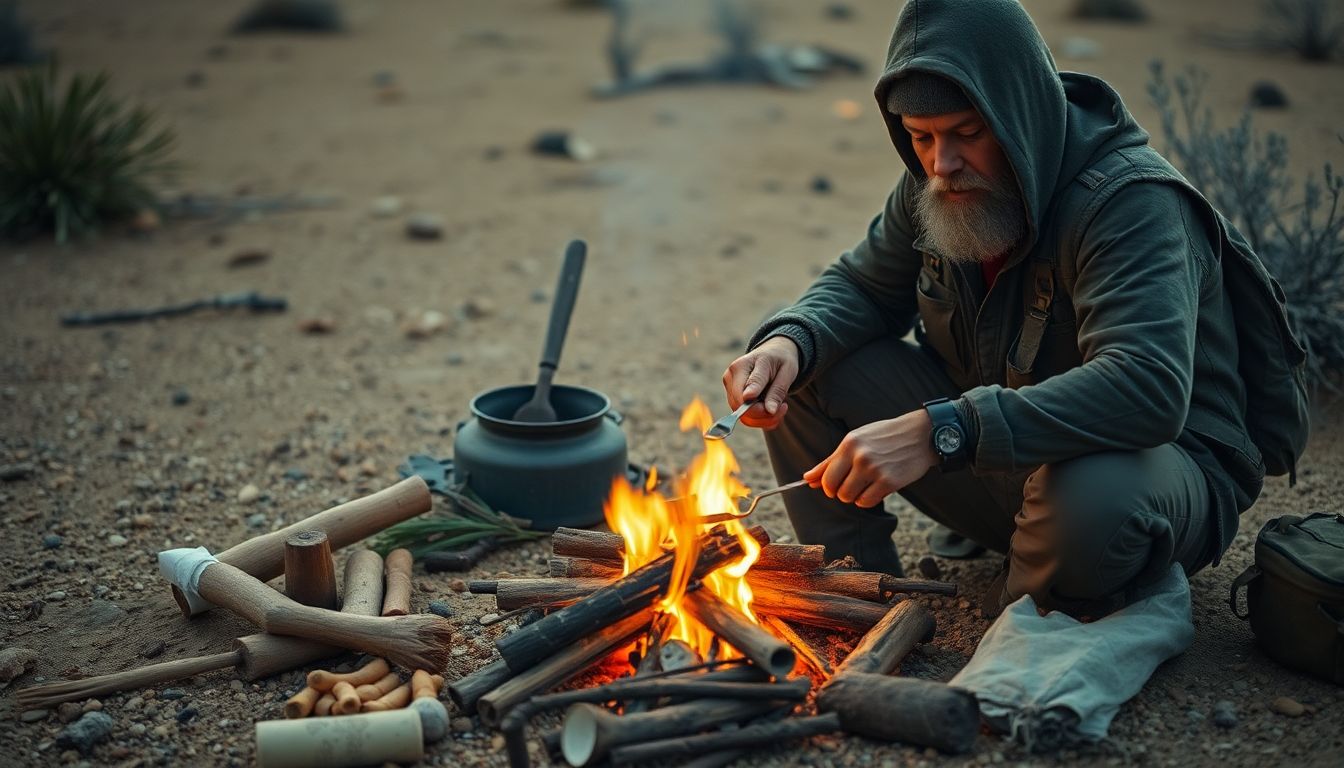
Food: Foraging and Hunting in the Desert
In the vast, sun-drenched expanse of the desert, life thrives in unexpected ways, offering a unique opportunity for those who know where to look. Foraging and hunting in the desert can be a rewarding experience, provided one approaches it with respect and understanding. The key to sustainable desert foraging lies in knowing your local flora and fauna. Familiarize yourself with the native plants, such as the hardy creosote bush, the nutrient-rich prickly pear cactus, and the versatile mesquite tree. These plants not only provide food but also have medicinal properties and can be used to make tools or shelter. Always remember to take only what you need and leave enough for the plants to regenerate.
When it comes to hunting, the desert is home to a variety of animals, from jackrabbits and desert bighorn sheep to roadrunners and quails. Hunting should be done responsibly, following local regulations and ethical guidelines. It’s crucial to understand the animal’s behavior, habitat, and population density to ensure that your actions do not disrupt the ecosystem.
Preparing and preserving food in the desert environment requires creativity and resourcefulness. The sun’s intense heat can be used to your advantage for drying and preserving meats and fruits. For example, you can create a solar oven using a cardboard box and aluminum foil to cook food slowly and evenly. Alternatively, you can bury food in the ground to cook it using the earth’s natural heat, a method known as ‘earth oven’ or ‘hobot’. To preserve food, consider smoking, salting, or fermenting. These methods not only extend the shelf life of food but also add depth of flavor.
Lastly, always be mindful of the desert’s delicate balance. Avoid foraging or hunting in protected areas, and never disturb sensitive habitats. By respecting the desert and its inhabitants, we can ensure that future generations can continue to enjoy and learn from this unique environment.

First Aid and Medical Care in the Desert
The desert, a harsh and unforgiving environment, presents unique medical challenges that require specific knowledge and preparation. The extreme heat, intense sunlight, and scarcity of water can lead to dehydration, heat exhaustion, and heatstroke. Additionally, the desert is home to venomous creatures like snakes and scorpions, and the risk of infection from minor injuries is high due to the presence of sand and dust. A well-stocked first aid kit is not just important, but crucial in such an environment.
Your first aid kit should include essentials like bandages, antiseptic wipes, tweezers, medical gloves, a CPR mask, and a first aid manual. It’s also wise to carry a snake bite kit, antihistamines for allergic reactions, and a basic supply of any prescription medications you might need. Remember, prevention is key. Wear protective clothing, use sunscreen, and stay hydrated to minimize the risk of heat-related illnesses.
If you or someone else experiences heat exhaustion, move to a cooler place, hydrate, and cool down using wet cloths or a shower. If symptoms worsen or heatstroke is suspected, seek immediate medical help. For snake bites, keep calm, call emergency services, and try to remember the snake’s color and shape. Do not attempt to suck out the venom or apply a tourniquet. For scorpion stings, follow similar steps, noting the scorpion’s color and size. Always prioritize safety and seek professional medical help when needed.
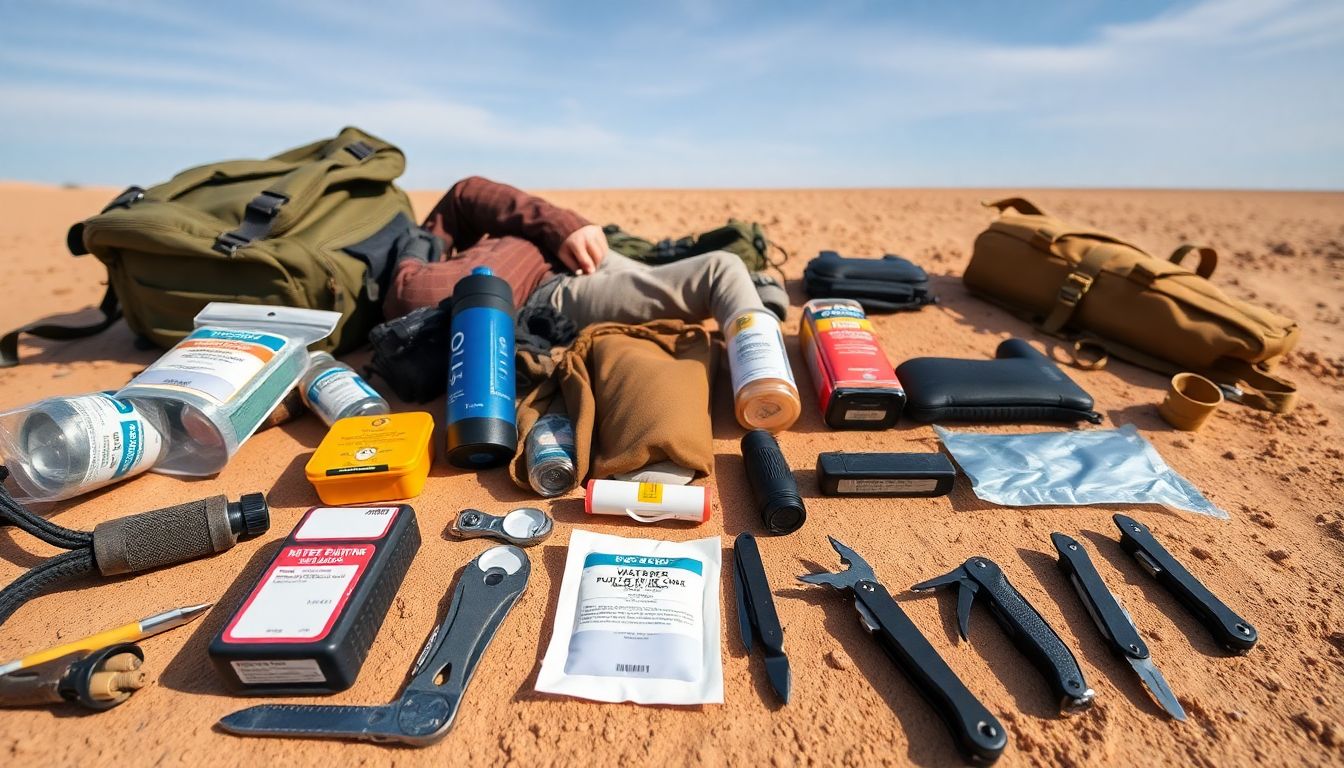
Desert Survival Gear: Essentials and Nice-to-Haves
Embarking on a desert adventure requires careful planning and selection of gear. The desert, with its harsh conditions and limited resources, demands a balance between essentials and nice-to-haves. Let’s delve into the world of desert survival gear, exploring the must-haves, the luxuries, and how to pack them effectively.
The first category, essentials, includes items that are non-negotiable for your safety and survival. A reliable water source is paramount, with a water filter or purification tablets being top priorities. A sturdy, wide-brimmed hat and sunglasses protect against the relentless sun, while a high-SPF sunscreen ensures your skin doesn’t bear the brunt of the desert’s wrath. A well-ventilated, lightweight clothing ensemble, a first aid kit, a map, compass, and a headlamp round off the essentials list.
Now, let’s consider the nice-to-haves, items that enhance your comfort and experience but aren’t strictly necessary. A hammock and bug net can provide a comfortable night’s sleep, while a camp chair and a portable stove can make your downtime more enjoyable. A satellite phone or personal locator beacon offers peace of mind, while a camera can capture the desert’s stark beauty.
Choosing gear involves balancing weight, durability, and functionality. For instance, a lightweight, quick-drying tent might be preferable to a heavier, more durable one. Consider the desert’s unique challenges
- extreme temperatures, sand, and sun
- when selecting gear. Always opt for gear with a good track record in harsh environments.
Packing effectively is key to a successful desert expedition. Use packing cubes or stuff sacks to keep your gear organized and prevent sand from infiltrating your pack. Place frequently used items in easy-to-reach pockets, and keep heavy items close to your back to maintain balance. Remember, every ounce counts in the desert, so leave non-essential items behind.
Finally, maintaining and repairing gear in the desert is crucial. Regularly clean and inspect your gear for signs of wear. Use a soft brush to remove sand from zippers and seams, and apply silicone-based lubricant to keep them functioning smoothly. For repairs, carry a basic sewing kit, duct tape, and any specific repair tools or parts recommended by the manufacturer. With proper care, your gear will serve you well in the desert’s unforgiving landscape.

Desert Survival Psychology: Maintaining a Positive Mindset
Embarking on a desert survival journey presents a unique set of psychological challenges, with isolation, extreme temperatures, and scarcity of resources pushing our minds to their limits. The desert’s vast, unchanging landscape can induce feelings of hopelessness and despair, while the constant stress of survival can lead to anxiety and irritability. Maintaining a positive mindset in such conditions is not merely a luxury; it’s a necessity for survival.
The first step in preserving mental well-being is understanding that the desert is not an enemy, but a challenge to be overcome. Instead of dwelling on the harsh conditions, focus on the beauty and uniqueness of the desert. Appreciate the vastness of the night sky, the play of light and shadow on the sand dunes, and the resilience of life that persists in this seemingly barren environment.
Another crucial aspect is maintaining a sense of purpose and control. Set achievable goals, such as finding water, building a shelter, or navigating to a specific point. Break down larger tasks into smaller, manageable steps. This not only helps in making progress but also boosts your confidence and sense of accomplishment.
Teamwork and communication are vital in desert survival. If you’re with others, support each other’s morale. Share stories, laughter, and hope. If you’re alone, imagine a supportive team around you. This mental construct can provide a sense of companionship and shared purpose.
Planning and preparation are key to mitigating stress. Before setting out, learn about the desert’s unique challenges and how to overcome them. Pack essential items like a map, compass, water purification tablets, and high-energy food. Knowing you’re well-prepared can significantly reduce anxiety.
Lastly, remember that it’s normal to feel overwhelmed at times. Don’t suppress these feelings; acknowledge them and then let them go. Practice mindfulness and deep breathing exercises to stay centered and calm. Keep a journal to process your thoughts and emotions. In the vast, silent expanse of the desert, your mind is your most powerful tool for survival.





